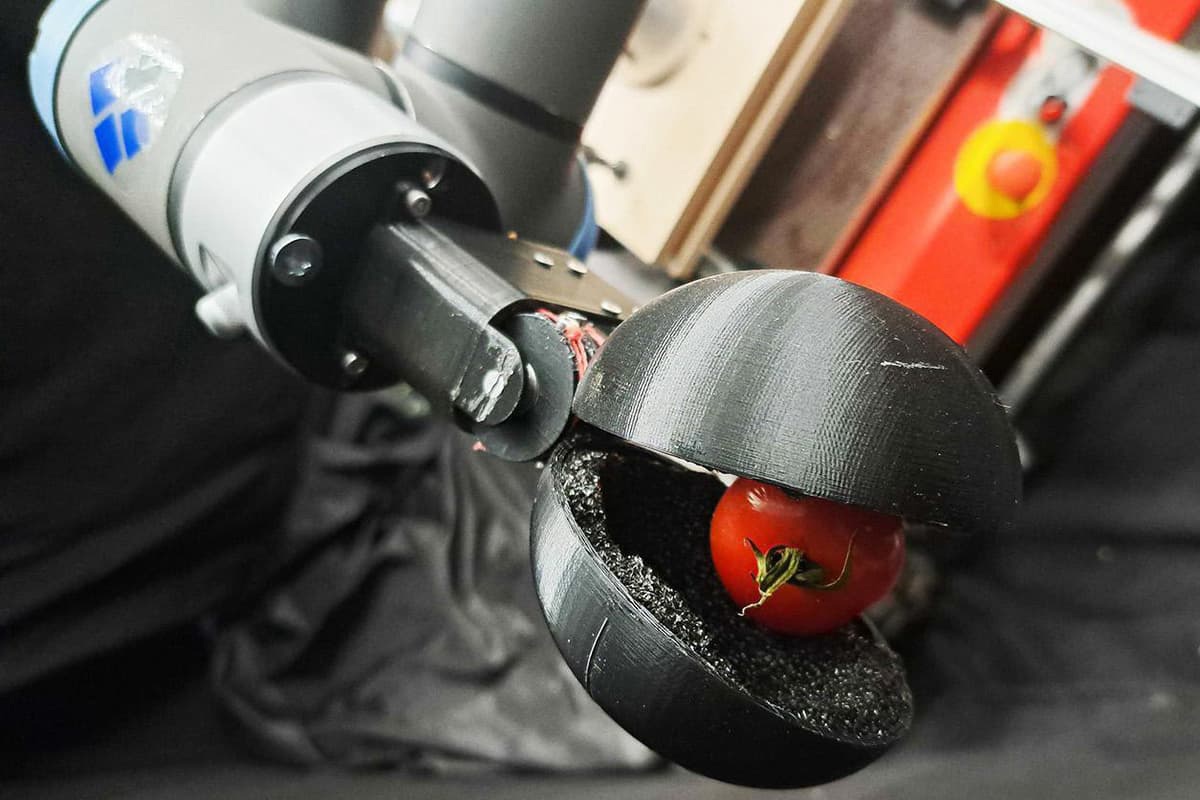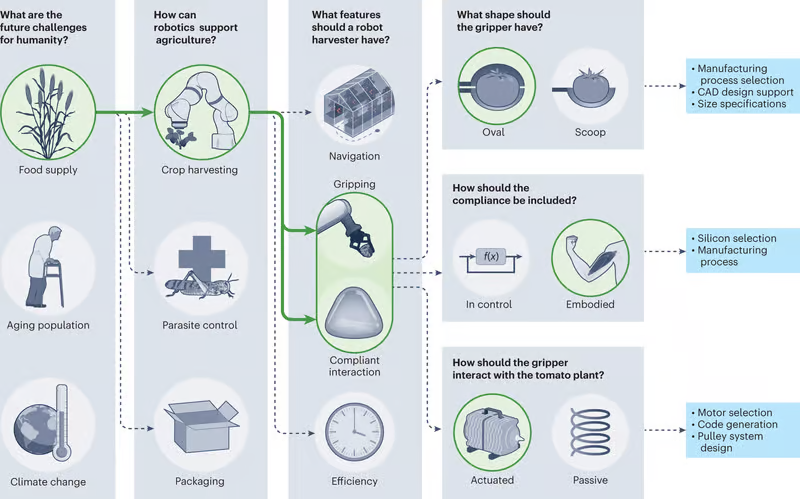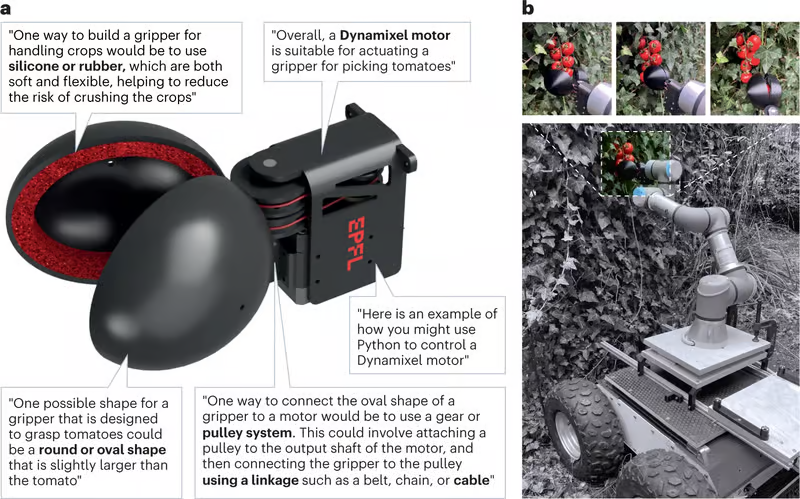 Technology peripherals
Technology peripherals
 AI
AI
 Researchers use ChatGPT to build a tomato picking robot, demonstrating the infinite possibilities of artificial intelligence
Researchers use ChatGPT to build a tomato picking robot, demonstrating the infinite possibilities of artificial intelligence
Researchers use ChatGPT to build a tomato picking robot, demonstrating the infinite possibilities of artificial intelligence
News on June 8, recently, some researchers used the help of ChatGPT to build a tomato picking robot.

OpenAI’s ChatGPT is a language model that can process and understand large amounts of text data and use this information to answer questions. In a new case study, researchers from Delft University of Technology in the Netherlands and the Swiss Federal Institute of Technology turned to ChatGPT-3 for help in designing and building a robot.
This sounds a bit strange because ChatGPT-3 is a language model, not a mechanical model. "Although ChatGPT-3 is a language model, its code generation is also text-based, providing important insights and intuition for physical design and showing great potential to inspire human creativity," said study co-author Josie Hughes said.
First, the researchers asked the AI model, "What are the challenges facing humanity in the future?" ChatGPT-3 came up with three: food supply, population aging, and climate change. The researchers chose food supply as a robot design direction and then asked ChatGPT-3 what characteristics a tomato harvesting robot should have. ChatGPT-3 proposes a motor-driven gripper for plucking ripe tomatoes from the vine.
Once this rough design is determined, researchers can make decisions about design details, including what materials to use and what control code to write. Currently, language models cannot generate complete computer-aided design (CAD) models, evaluate codes, or automatically manufacture robots, so this step requires researchers to play the role of "technicians" to assist in these aspects and optimize the code written by the language model. Complete the CAD and build the robot.

The questions posed by the researchers are presented above, while the options provided by the language model are shown below. Human decision trees, shaded green, gradually focus the problem in a direction consistent with their goals.
With technical advice provided by ChatGPT-3, the researchers built their robotic gripper and tested it in the real world, using it to pick tomatoes, with successful results.

b. Technical suggestions, including shape instructions, coding, component and material selection, mechanical design, etc., for generating language models. b. Guided by these inputs, a clamp was built and tested on real-world tasks, such as tomato picking, as shown on the right.
The researchers say their case study demonstrates the potential for collaboration between humans and language models to transform the design process, but they also realize this collaboration may come in varying degrees.
An extreme approach, they say, is for AI to act as the "inventor," providing all input into the robot's design, while humans just blindly apply it. Another approach is to use AI’s extensive knowledge to supplement human expertise. The third way is to retain humans as inventors and use artificial intelligence to troubleshoot, debug and handle tedious or time-consuming processes to optimize the design process.
Researchers have raised some of the ethical and common sense risks that may arise from AI working with humans, citing issues such as bias, plagiarism and intellectual property as areas of concern.
“In our study, ChatGPT-3 identified tomatoes as the most worthy crop to design a harvesting robot for,” Hughes said. “However, this may be a bias against crops with greater literature coverage, Rather than crops that are truly in need. When decisions are made beyond an engineer's knowledge, this can lead to serious ethical, engineering, or factual errors."
Despite these problems, researchers believe that if managed properly, artificial intelligence There is great potential for collaboration with humans.
This case study was published in the journal "Natural Machine Intelligence". You can click here to view details.
The above is the detailed content of Researchers use ChatGPT to build a tomato picking robot, demonstrating the infinite possibilities of artificial intelligence. For more information, please follow other related articles on the PHP Chinese website!

Hot AI Tools

Undresser.AI Undress
AI-powered app for creating realistic nude photos

AI Clothes Remover
Online AI tool for removing clothes from photos.

Undress AI Tool
Undress images for free

Clothoff.io
AI clothes remover

AI Hentai Generator
Generate AI Hentai for free.

Hot Article

Hot Tools

Notepad++7.3.1
Easy-to-use and free code editor

SublimeText3 Chinese version
Chinese version, very easy to use

Zend Studio 13.0.1
Powerful PHP integrated development environment

Dreamweaver CS6
Visual web development tools

SublimeText3 Mac version
God-level code editing software (SublimeText3)

Hot Topics
 1384
1384
 52
52
 ChatGPT now allows free users to generate images by using DALL-E 3 with a daily limit
Aug 09, 2024 pm 09:37 PM
ChatGPT now allows free users to generate images by using DALL-E 3 with a daily limit
Aug 09, 2024 pm 09:37 PM
DALL-E 3 was officially introduced in September of 2023 as a vastly improved model than its predecessor. It is considered one of the best AI image generators to date, capable of creating images with intricate detail. However, at launch, it was exclus
 A new programming paradigm, when Spring Boot meets OpenAI
Feb 01, 2024 pm 09:18 PM
A new programming paradigm, when Spring Boot meets OpenAI
Feb 01, 2024 pm 09:18 PM
In 2023, AI technology has become a hot topic and has a huge impact on various industries, especially in the programming field. People are increasingly aware of the importance of AI technology, and the Spring community is no exception. With the continuous advancement of GenAI (General Artificial Intelligence) technology, it has become crucial and urgent to simplify the creation of applications with AI functions. Against this background, "SpringAI" emerged, aiming to simplify the process of developing AI functional applications, making it simple and intuitive and avoiding unnecessary complexity. Through "SpringAI", developers can more easily build applications with AI functions, making them easier to use and operate.
 Choosing the embedding model that best fits your data: A comparison test of OpenAI and open source multi-language embeddings
Feb 26, 2024 pm 06:10 PM
Choosing the embedding model that best fits your data: A comparison test of OpenAI and open source multi-language embeddings
Feb 26, 2024 pm 06:10 PM
OpenAI recently announced the launch of their latest generation embedding model embeddingv3, which they claim is the most performant embedding model with higher multi-language performance. This batch of models is divided into two types: the smaller text-embeddings-3-small and the more powerful and larger text-embeddings-3-large. Little information is disclosed about how these models are designed and trained, and the models are only accessible through paid APIs. So there have been many open source embedding models. But how do these open source models compare with the OpenAI closed source model? This article will empirically compare the performance of these new models with open source models. We plan to create a data
 How to install chatgpt on mobile phone
Mar 05, 2024 pm 02:31 PM
How to install chatgpt on mobile phone
Mar 05, 2024 pm 02:31 PM
Installation steps: 1. Download the ChatGTP software from the ChatGTP official website or mobile store; 2. After opening it, in the settings interface, select the language as Chinese; 3. In the game interface, select human-machine game and set the Chinese spectrum; 4 . After starting, enter commands in the chat window to interact with the software.
 Posthumous work of the OpenAI Super Alignment Team: Two large models play a game, and the output becomes more understandable
Jul 19, 2024 am 01:29 AM
Posthumous work of the OpenAI Super Alignment Team: Two large models play a game, and the output becomes more understandable
Jul 19, 2024 am 01:29 AM
If the answer given by the AI model is incomprehensible at all, would you dare to use it? As machine learning systems are used in more important areas, it becomes increasingly important to demonstrate why we can trust their output, and when not to trust them. One possible way to gain trust in the output of a complex system is to require the system to produce an interpretation of its output that is readable to a human or another trusted system, that is, fully understandable to the point that any possible errors can be found. For example, to build trust in the judicial system, we require courts to provide clear and readable written opinions that explain and support their decisions. For large language models, we can also adopt a similar approach. However, when taking this approach, ensure that the language model generates
 Rust-based Zed editor has been open sourced, with built-in support for OpenAI and GitHub Copilot
Feb 01, 2024 pm 02:51 PM
Rust-based Zed editor has been open sourced, with built-in support for OpenAI and GitHub Copilot
Feb 01, 2024 pm 02:51 PM
Author丨Compiled by TimAnderson丨Produced by Noah|51CTO Technology Stack (WeChat ID: blog51cto) The Zed editor project is still in the pre-release stage and has been open sourced under AGPL, GPL and Apache licenses. The editor features high performance and multiple AI-assisted options, but is currently only available on the Mac platform. Nathan Sobo explained in a post that in the Zed project's code base on GitHub, the editor part is licensed under the GPL, the server-side components are licensed under the AGPL, and the GPUI (GPU Accelerated User) The interface) part adopts the Apache2.0 license. GPUI is a product developed by the Zed team
 Don't wait for OpenAI, wait for Open-Sora to be fully open source
Mar 18, 2024 pm 08:40 PM
Don't wait for OpenAI, wait for Open-Sora to be fully open source
Mar 18, 2024 pm 08:40 PM
Not long ago, OpenAISora quickly became popular with its amazing video generation effects. It stood out among the crowd of literary video models and became the focus of global attention. Following the launch of the Sora training inference reproduction process with a 46% cost reduction 2 weeks ago, the Colossal-AI team has fully open sourced the world's first Sora-like architecture video generation model "Open-Sora1.0", covering the entire training process, including data processing, all training details and model weights, and join hands with global AI enthusiasts to promote a new era of video creation. For a sneak peek, let’s take a look at a video of a bustling city generated by the “Open-Sora1.0” model released by the Colossal-AI team. Open-Sora1.0
 Microsoft, OpenAI plan to invest $100 million in humanoid robots! Netizens are calling Musk
Feb 01, 2024 am 11:18 AM
Microsoft, OpenAI plan to invest $100 million in humanoid robots! Netizens are calling Musk
Feb 01, 2024 am 11:18 AM
Microsoft and OpenAI were revealed to be investing large sums of money into a humanoid robot startup at the beginning of the year. Among them, Microsoft plans to invest US$95 million, and OpenAI will invest US$5 million. According to Bloomberg, the company is expected to raise a total of US$500 million in this round, and its pre-money valuation may reach US$1.9 billion. What attracts them? Let’s take a look at this company’s robotics achievements first. This robot is all silver and black, and its appearance resembles the image of a robot in a Hollywood science fiction blockbuster: Now, he is putting a coffee capsule into the coffee machine: If it is not placed correctly, it will adjust itself without any human remote control: However, After a while, a cup of coffee can be taken away and enjoyed: Do you have any family members who have recognized it? Yes, this robot was created some time ago.



